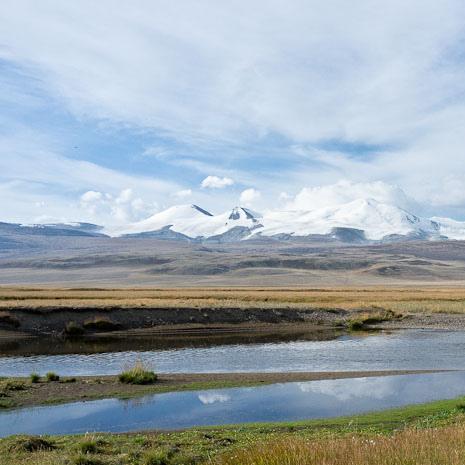Affectionately known as ‘Princess Ukok’ after the Altai Mountain site of her burial and subsequent rediscovery, the 2,500-year-old ice-preserved corpse of a young woman in her mid-20s has caused a sensation in archaeological circles—as well as within the cannabis community, due to compelling evidence of her medicinal cannabis use. The tomb of the so-called Princess Ukok was discovered in 1993 on the Ukok Plateau, a flat stretch of grassland nestled in the heart of the Altai Republic, which lies in southwestern Siberia near the borders with China and Mongolia. The discovery was made by Russian archaeologists during excavations in the Pazyryk Valley, a low-lying section of the Plateau, along with numerous other tombs (known as ‘kurgans’ in the local dialect) and artefacts of the period. On the basis of these findings, the Pazyryk Culture is the name now given to the Iron Age society that inhabited the region from the 6th – 3rd centuries BCE, of which Princess Ukok was apparently a notable member.
The ‘Princess’ is also commonly referred to as the Siberian Ice Maiden, or as Devochka or Ochi-Bala—the former simply translates to ‘girl’ in Russian, while the latter is the name of a warrior huntress featuring in the Altaic Heroic Epics that constitute a vital part of the oral traditions of the Turkic peoples of northwest Asia.
Affectionately known as ‘Princess Ukok’ after the Altai Mountain site of her burial and subsequent rediscovery, the 2,500-year-old ice-preserved corpse of a young woman in her mid-20s has caused a sensation in archaeological circles—as well as within the cannabis community, due to compelling evidence of her medicinal cannabis use.

Who was Princess Ukok?
The tomb of the so-called Princess Ukok was discovered in 1993 on the Ukok Plateau, a flat stretch of grassland nestled in the heart of the Altai Republic, which lies in southwestern Siberia near the borders with China and Mongolia. The discovery was made by Russian archaeologists during excavations in the Pazyryk Valley, a low-lying section of the Plateau, along with numerous other tombs (known as ‘kurgans’ in the local dialect) and artefacts of the period. On the basis of these findings, the Pazyryk Culture is the name now given to the Iron Age society that inhabited the region from the 6th – 3rd centuries BCE, of which Princess Ukok was apparently a notable member.
The ‘Princess’ is also commonly referred to as the Siberian Ice Maiden, or as Devochka or Ochi-Bala—the former simply translates to ‘girl’ in Russian, while the latter is the name of a warrior huntress featuring in the Altaic Heroic Epics that constitute a vital part of the oral traditions of the Turkic peoples of northwest Asia.
Princess, or shaman?
Rather than a princess, it is believed that the Ice Maiden was perhaps a shaman or healer, as her tomb has various features that indicate her high status, but is noticeably different from tombs thought to belong to royalty. A row of nearby tombs are believed to contain the remains of royal individuals, while the Ice Maiden’s tomb is separate and isolated, although still prominently situated.
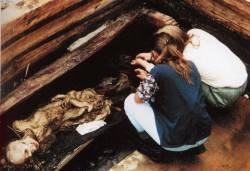
She is not buried with weapons, leading researchers to surmise that she was not one of the high-status warrior women thought to be an important part of Altaic society. Jewellery found interred with the cadaver is typically wooden with gold plate, and is somewhat inferior to the solid metal items associated with Pazyryk royalty. The Princess is also buried alone, which is unusual for a culture that typically interred couples together (in some cases, women were poisoned to render this possible); this may have indicated her celibacy, a condition often associated with shamanism or priesthood.
However, her garments were of exceptional quality—a tunic made from wild yellow silk, a striped woollen skirt, and long, richly-decorated felt boots. To the Pazyryk people of that time, it is thought that silk was rarer and perhaps even more valuable than gold, as it is typically found only in ‘royal’ Pazyryk burials. Her internal organs were also removed subsequent to death and her body mummified, in the same manner as royalty.
The tragic demise of Princess Ukok
Undoubtedly, Princess Ukok was and is a figure of great significance and power, and is almost as revered by the present-day inhabitants of the Altai Mountains as she would have been by her contemporaries. It is thought that due to her status as shaman, great efforts were made to preserve her life—but ultimately she was to meet a tragic and untimely death.
There is evidence to suggest that the Ice Maiden suffered from osteomyelitis (bone or bone-marrow infection) from childhood or early adolescence, which would in all likelihood have caused her significant pain and possibly disabled her. For a nomadic equestrian society such as the Pazyryk is thought to have been, weak or disabled individuals would have had extreme difficulty keeping up with their healthy peers, and it is likely that such an individual would have needed to boast some special significance to her people for extra consideration to be paid to her survival.
Analysis of the preserved corpse has indicated that at around the age of twenty, the Princess began to suffer from breast cancer; the tumours grew and metastasised, and by the time she was around twenty-five, ultimately led to her death (although some estimate her death to have been somewhat later, at around twenty-eight). It is thought that the burial site was part of a traditional winter camp, which the tribe would have returned to each year when the weather grew colder. Injuries along the right side of her body indicate a fall from significant height some months prior to death, potentially a result of falling off her horse due to progressive weakness during the journey to the site.
Princess Ukok used cannabis to ease cancer pain
Due to her ongoing illnesses, it is likely that the Ice Maiden would have needed to avail herself of the strongest available painkillers. It is known that the peoples of the Altai Mountains have long made use of wine, opium, henbane, mandrake, goldenroot and ephedra as part of their extensive natural pharmacopoeia; as well as this, there is substantial evidence indicating that they also made use of cannabis. In fact, a small container buried with the body has been confirmed as containing cannabis leaves, flowers, and seeds, as have several similar containers found in nearby tombs.
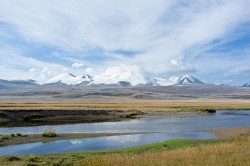
With the benefit of modern research, we are now increasingly aware of the ability of cannabis to manage various types of chronic pain, including that resulting from cancer. Furthermore, while apparently no studies have specifically looked at cannabis’ ability to ameliorate symptoms of osteomyelitis, it is now known that the endocannabinoid system has a crucial role to play in the regulation of the skeletal system. Specifically, CB2-receptors are present in high concentrations in the osteoblasts, where they help to stimulate formation of new bone tissue, and in the osteoclasts, where they inhibit its resorption. Furthermore, cannabinoids have been shown to have some ability to treat amyloidosis, a build-up of mis-folded proteins that is a secondary symptom of osteomyelitis and several other diseases.
The nature of Pazyryk shamanism
It is postulated that living with a chronic and debilitating illness may actually have worked in the Ice Maiden’s favour, at least in terms of securing status within the tribe. Physical frailty, inactivity and closeness to death often go hand-in-hand with perceived spirituality and asceticism; this concept is still very evident within Hindu Sadhu culture, and was not unknown to early Christians and various other religions.
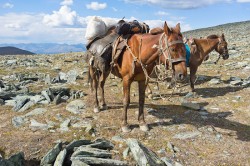
The reason for this is perhaps partly that mental acuity and meditative ability can be honed in spite of—perhaps even due to—physical weakness, and perhaps also that the concepts one finds oneself focusing on when permanently very ill are concerned with the human condition and the hereafter (or ‘spirit world’, in many belief systems) as a matter of course.
As well as easing chronic pain, use of mind-altering substances such as cannabis may also have assisted the Princess in shamanic practices—due to their potentially mind-altering effects, which have been utilised throughout history in shamanic cultures to achieve communion with the ‘spirits’, or achieve the trance-like state of consciousness believed to be crucial for curing sickness in others.
Pazyryk cannabis use
Aside from the container found in the tomb of the Princess Ukok, there have been several other archaeological finds that indicate that cannabis use was prevalent and widespread in the Pazyryk Culture. Prior to the 1993 excavations, a series of digs in the region were conducted by the eminent Russian anthropologist Sergei Rudenko between 1929 and 1949.
In every tomb uncovered, a ‘personal hemp-burning kit’ with signs of wear and tear was discovered alongside everyday items such as weapons and tools, indicating that the kits would have been regularly used. The kits consisted of a tipi-like felt and leather structure supported by six poles, and small bronze braziers filled with stones and charred cannabis seeds—very similar to the braziers described by Herodotus, in his famous reports of Scythian cannabis use. Small leather bags containing cannabis seeds and other fragrant seeds such as coriander and yellow clover were also found in some of the tombs.
Cultural exchange between the Scythians and the Pazyryks
The Pazyryk Culture was closely related to the dominant Scythian culture of the Central Asian steppes that lie to the southwest of the Altai Mountains. It is quite common to find Pazyryk and Altaic peoples referred to as being Scythian, but while they certainly appear to have had ongoing contact and exchange of ideas, they were independent of each other, with different (although related) languages, ethnicities and traditions. The Scythians are generally considered an Iranian people (although some scholars postulate an Altaic origin) that migrated from the Central Asian steppes to southern Russia; on the other hand, Altaic peoples generally fall into the Turkic (western), Mongol (central) and Tungusic (eastern) ethnic groups. There remains some controversy regarding the Pazyryk Culture itself, but it is generally considered to be proto-Turkic.

Despite the complexities of establishing the exact cultural background of the Ice Maiden and her people, the degree of cultural exchange that went on between the ancient peoples of the region suggests that knowledge of medicinal herbs such as cannabis would have widespread during the time she lived and died. Her lifespan, although short, may have overlapped or slightly preceded that of Herodotus, who penned his famous descriptions of Scythian cannabis vapour-baths in around 450 – 420 BCE.
Scythian use of cannabis—at first believed to be an inaccuracy or lie on Herodotus’ part—has been confirmed by analysis of the contents of various tombs found in Central Asia. A stone container recently discovered in a Scythian tomb in Kazakhstan was found to hold cannabis seeds and flowers, plus eight rounded pebbles thought to be used as heating stones.
The final resting place of Princess Ukok
Just as great efforts were made to preserve her life, great efforts have been to preserve the Princess Ukok in death. Initially, the people of her tribe took great care and attention when removing her organs and embalming her body, and buried her with reverence and dignity. When disinterred thousands of years later, her corpse almost immediately began to decay, due to being rapidly unfrozen and exposed to the elements (and pathogens such as fungi, which immediately began to colonise what remained of her skin and flesh).
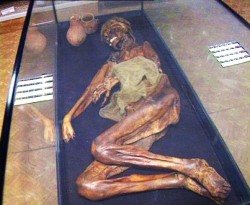
As a result, she was moved with all haste to Novosibirsk, and shortly afterwards to a research facility in Gorno-Altaysk (the capital of the Altai Republic), where she was unceremoniously dumped in ‘pickling’ alcohol in much the same manner as the Soviet leader Vladimir Lenin in 1924. She has remained there ever since, which has served to control the decomposition of the remains.
However, the present-day tribal leaders of the Altai Republic (which had just been formed from the ashes of the Gorno-Altai Autonomous Soviet Socialist Republic in 1992, the year prior to the excavations) are not pleased with the Russian scientists’ attempts to preserve the Ice Maiden, and believe that the original efforts made by their ancestors were quite sufficient. Indeed, they feel that she should be returned to her original resting place, and believe that the increase in floods, earthquakes and avalanches perceived since her forced relocation are a direct result of her spirit’s anger at her earthly body being moved.
The people of the region retain a strong sense of tradition and ancestor-worship, and the case of the Ice Maiden to them serves as an example of how an unwanted outside influence can upset and insult the delicate existence they have carefully preserved over the millennia. Certainly, the information we have gleaned from the Princess Ukok is ground-breaking, but the need to respect existing populations who may share kinship with her perhaps overrides this fact.






